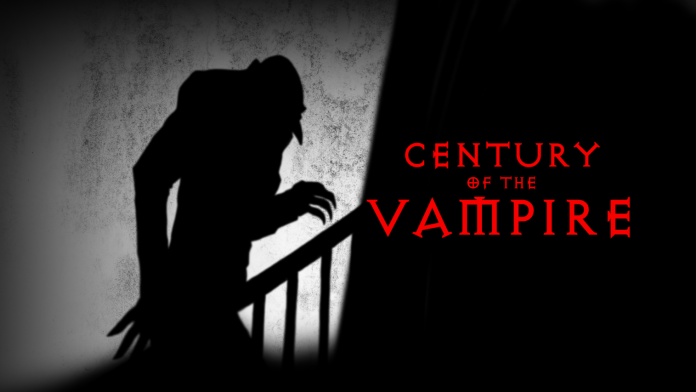Welcome to the Century of the Vampire, an ongoing weekly feature where Goonhammer managing editor Jonathan Bernhardt watches some piece of vampire media, probably a movie but maybe eventually television will get a spot in here too, and talks about it at some length in the context of both its own value as a piece of art and as a representation of the weird undead guys that dominate western pop culture who aren’t (usually) zombies.
Last week, Bernhardt reviewed the 2005 Uwe Boll film BloodRayne. Today, Bernhardt looks at the 2002 Michael Rymer film, Queen of the Damned. This article will contain spoilers.
Queen of the Damned is not a good movie, but it is a real movie-ass movie, and an obvious product of the early 2000s love affair with MTV, the cable cultural juggernaut that was going to live forever, and nu-metal, the soundtrack of the times. And after BloodRayne I absolutely needed something like this to restore normalcy to this column. Not a masterpiece by any means, but you don’t give the parched man in the desert the entire waterskin at first; you have him sip a little bit at a time. Queen of the Damned was a tiny bit of good vampire filmmaking.
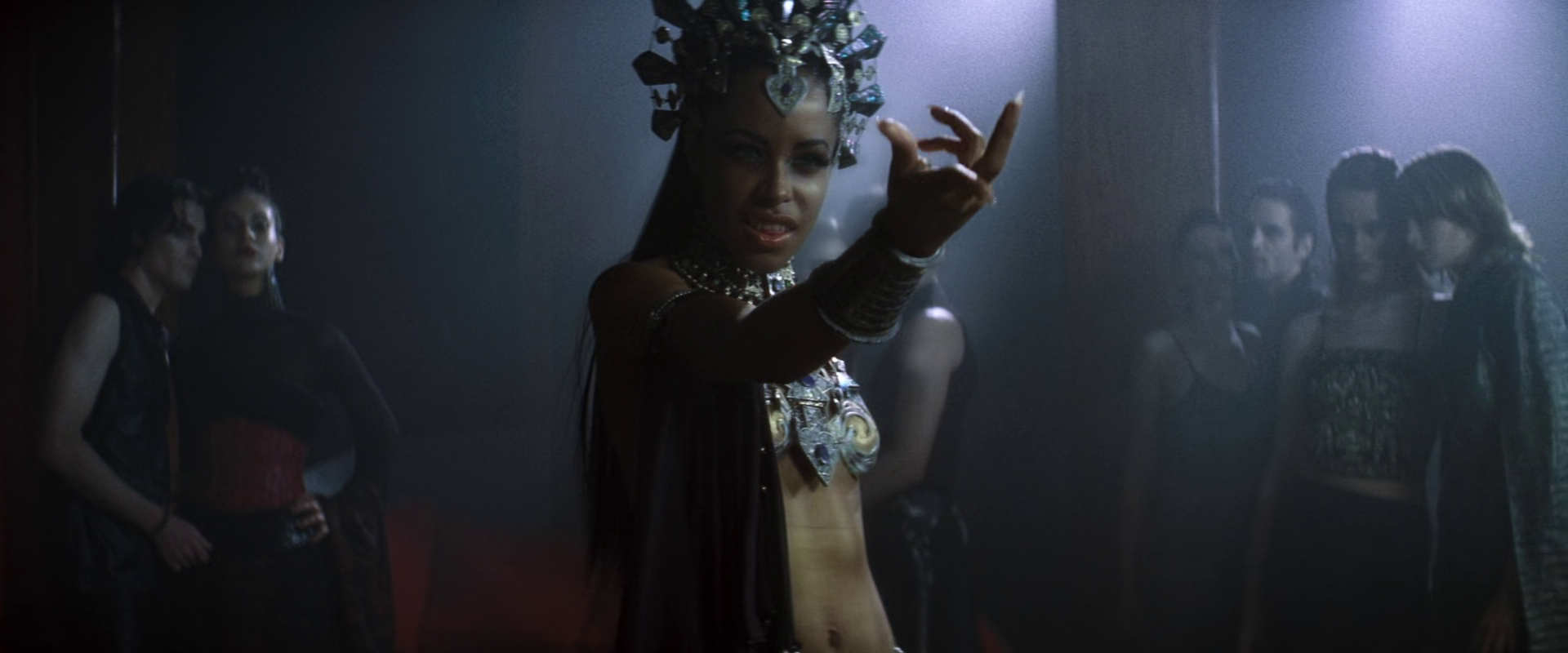
The film is most well-known for being both the star turn and tragic last appearance of R&B/pop singer Aaliyah, who died in a plane crash shortly after filming was completed on her scenes. It’s a bit surprising to learn this is all of her that was supposed to be in the movie, considering she’s the title role and led all of the marketing; she doesn’t show up until 50 minutes in unless you count some CGI statue shenanigans around the half-hour mark, and the film struggles to deploy her properly even once she’s arrived, which I suspect has something to do with the film being a very clumsy adaptation of two books mashed together instead of just the one it’s named after. Aaliyah’s Akasha, Mother of All Vampires, is a thinly-sketched character mostly there as a foil to the Lestat and Jesse romance that would go on to become much more culturally famous and impactful when a Mormon fanfic writer changed their names to Edward and Bella and made them incredibly repressive and weird about sex. Yes, Meyer’s take on the inspiration for Twilight is that it “came to her in a dream” in mid-2003 and was influenced by Shakespeare and Austin, but nothing is forcing us to ignore the evidence of our eyes here.
Queen of the Damned is pulled between the part of the film that either did or did not speak to Meyer so — the romance of the vampire and the human who wants to be part of the vampire’s world; the alien and all-powerful ancient contender for his hand who represents all the evils of the vampire’s nature, turned up to 11; alternatively rushed and tedious scenes about the Lore — and the arguably more interesting part, which is that Lestat wants to be in a rock band to fuck rules and suck chicks. It’s certainly the less-trod of the two paths the movie wants to take; the Blade films do the whole vampiric reluctance in the face of apocalyptic ancient evil schtick way better and Dracula 2000 had just two years prior hit basically all the same “tragedy of the immortals” beats that Lestat drops on Jesse in this film’s second act. However, sparkly Gerard Butler simply listened to nu-metal at a Virgin Records megastore; Lestat is born in it, molded by it. The movie’s opening minutes are him narrating, “Forget all that other stuff about me you may have seen in other movies. I went to sleep for a long time, and then a band rocking out in my old house woke me up because I loved their sick licks, heavy basslines and mixed rap-rock vocals so much. Because I was a violinist, you see.”
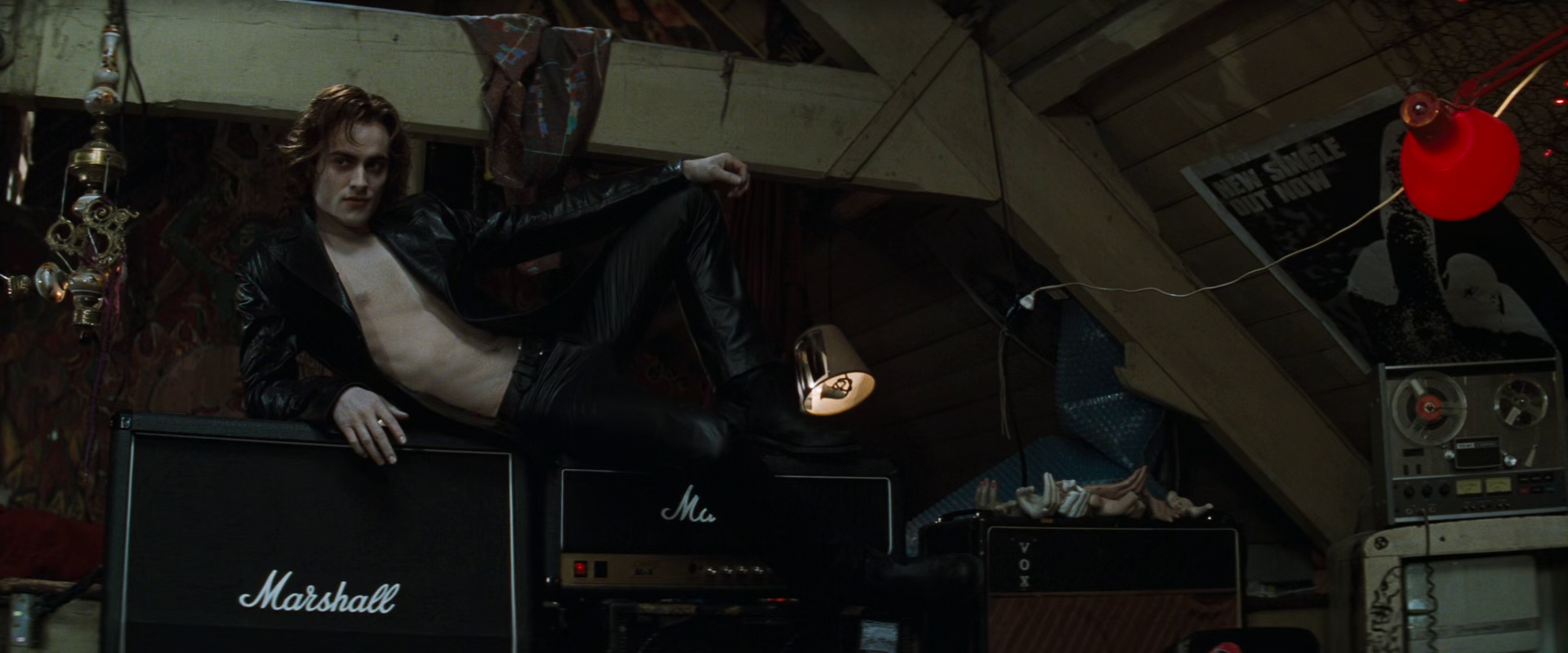
By minute five he’s sufficiently impressed the punk-ish rock-ish deadenders practicing in his old house (they’re played by a collection of actual musicians from the Australian metal and hardcore scene, with the commensurate acting skills) to get them on board with vampirism in general and for them specifically; by minute ten he’s an international sensation with a hit album and apparently no live touring plan — he’s just now setting up the band’s first and last big concert, in Death Valley. Judging by the questions at the London press conference (which he appears at remotely, though he will soon teleport to London to participate in the other half of the plot) he also hasn’t given any definitive proof that he’s a vampire and most of the world still thinks he’s a gimmick. The general reasoning here seems to be, well, Marilyn Manson was a big deal and he was just a weird creep instead of an incredibly beautiful Irish model. And sure, fair enough; one does wish they’d shown a bit more Evangelical counter-protesting of all of this. Maybe had the vampires eat a few in the process. But the idea here is that Lestat, due to the ennui and boredom of his eternal life in the shadows, is going to reveal and prove the existence of vampires to the whole world, and all the rest of the vampires want to kill him to stop that from happening. One supposes eating some stand-ins for the Westboro Baptist Church out on the curb would be counterproductive to those aims.
The music stuff is only the focus of the film for part of the first act and the very end of the second, but between the concert in Death Valley and the nature of the band itself, it’s responsible for all the funny or memorable moments in the hour and 44 minute runtime. It’s simply a great bit to have a rock band of vampires doing knock-off Orgy music videos, led by a shirtless sparkly male model vampire twink who opens his mouth to sing and the voice of Korn’s Jonathan Davis comes out. It’s just one of the funniest things you can do with the available materials. Everyone in the movie who hears him sing reacts like they’re hearing forbidden tones of unreal, unearthly beauty; when Lestat first deploys his vocals to his soon-to-be bandmates, it’s treated like the exercise of a vampiric superpower. The Korn guy! A vampire singing but it’s the Korn guy! It’s a crime he didn’t do any of Davis’s notorious scattish beatboxing, but perhaps that was being saved for the sequel that never was.
The concert he has out in Death Valley is the other really ambitious moment of the film, this time testing the CGI and stuntwork muscles that the production has to flex. It’s…a mixed bag at best. Alright, it’s pretty terrible, but in a fun way. The scene immediately preceding the opening pan across the expanse of “Death Valley” is one of the more overtly Edward-and-Bella-inspiring bits, where Jesse begs Lestat to show her what the vampire life is like, and feed off of her; instead, the tortured vampire soul snarls and turns away, then takes her to a nearby park, where another vampire is about to feed off an innocent woman. Lestat trivially scares this lesser vampire off, and Jesse happily goes, “Is she safe now?” The vampire hottie answers her by feeding on the woman himself to show her the monster he truly is, and as she is reduced to tears, he disappears into the night. There’s a beat as the scene fades out, and then: “OOO WAHH-AHH-AHH-AHH!” We are in Death Valley, and they have licensed Down with the Sickness.
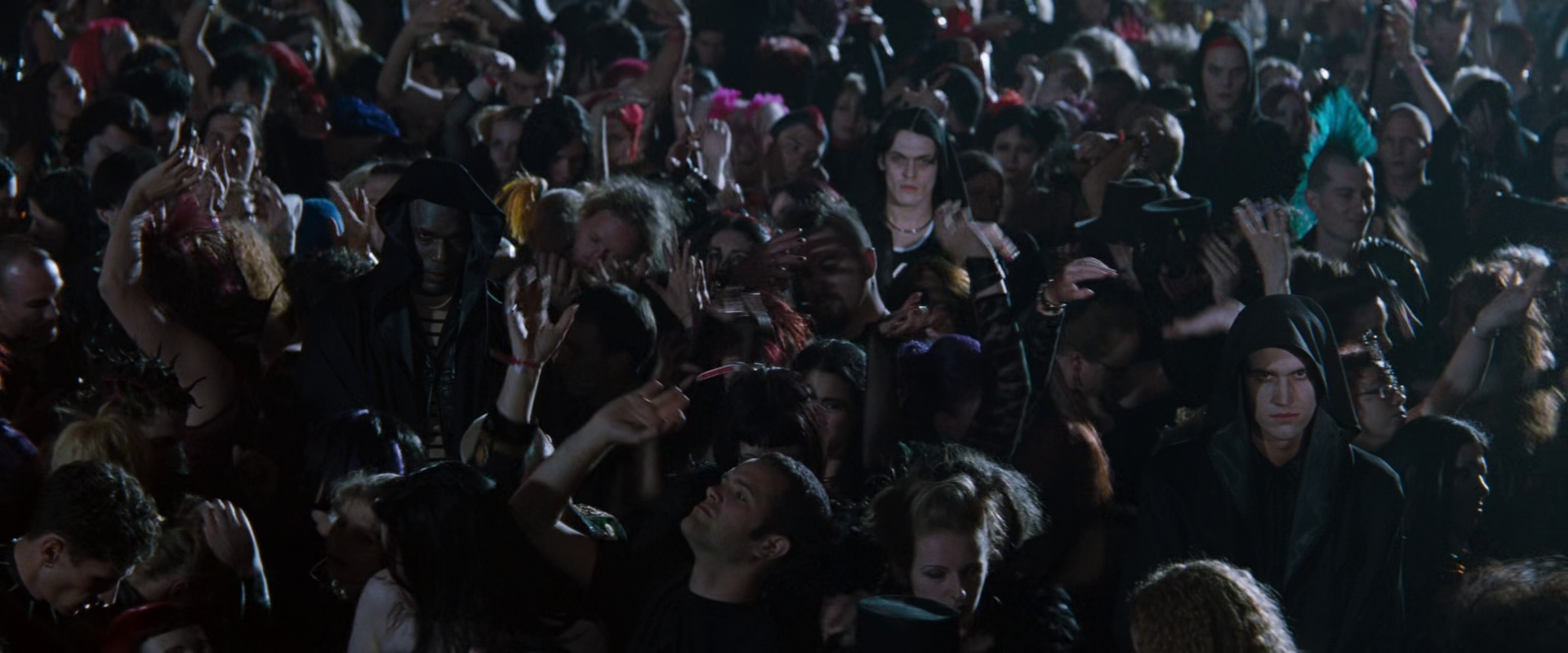
There’s an actual use of CGI here I really enjoyed the first time they deployed it; Lestat is standing out on the stage looking into the crowd of ravers and moshers doing nu-metal Woodstock in front of him and while all the humans are dancing around, they’ve used CGI to insert the vampires who have arrived to kill Lestat in their midst, such that the vampires are flatly lit and unnaturally still in the teeming mass of life. Then they go back to it again but speed the human dancers up and it ruins the whole effect, but hey, you had something there for a second.
The vampires attack, the band flees the stage, and Lestat’s erstwhile sire, Marius, leaps to his defense; the two vampire noblemen in their various capes and robes fight a bunch of vampire toughs in their dusters and trenchcoats. What’s important for a lot of the vampire fast-motion in this movie is that whoever’s doing it is wearing some kind of swooshy garment that can billow to create the impression of movement; whenever someone without that aesthetically-protective layer of fabric tries to active vampire superspeed, they look incredibly dumb, as Lestat does here since he’s in a mesh top (the film wisely chooses to have Townsend either shirtless or in a mesh top for the majority of his participation). This is the only extended fight scene in the film, and as such it’s our only opportunity to check in on where the technology and the technique is on the various styles of depicting vampire combat in 2002. Blade has already covered most ways to use guns and swords; in a couple years, Van Helsing will take a keen interest in the repeating crossbow, though the silver CGI bolts will be a bit rough. Here? Vampire karate!
Lestat and Marius’s actual martial arts style is difficult to pin down; as far as I know, no human form of hand-to-hand combat has a move where you deliver a wind-up chop to the back of a man’s leg as he’s moving past you and he pinwheels 20 feet above you in the air, which Marius does to a vampire who foolishly attacks him with a regular-sized knife. Lestat does something which looks vaguely like a heart punch with his hand in a tiger-style claw. Mostly our heroes do kicks and chops while their foes fly around on wires around them. Again, it’s weird that all these vampires decided to attack with four to six inch long knives. They’re vampires! The fight is not good, but it is fun to write the sentence, “and then the vampire Lestat hit him with a capoeira-style cartwheel kick for the crime of interrupting his rock concert.”
That’s when the Queen of the Damned shows up to incinerate all the trash mob vampires, and we have to talk about Aaliyah.
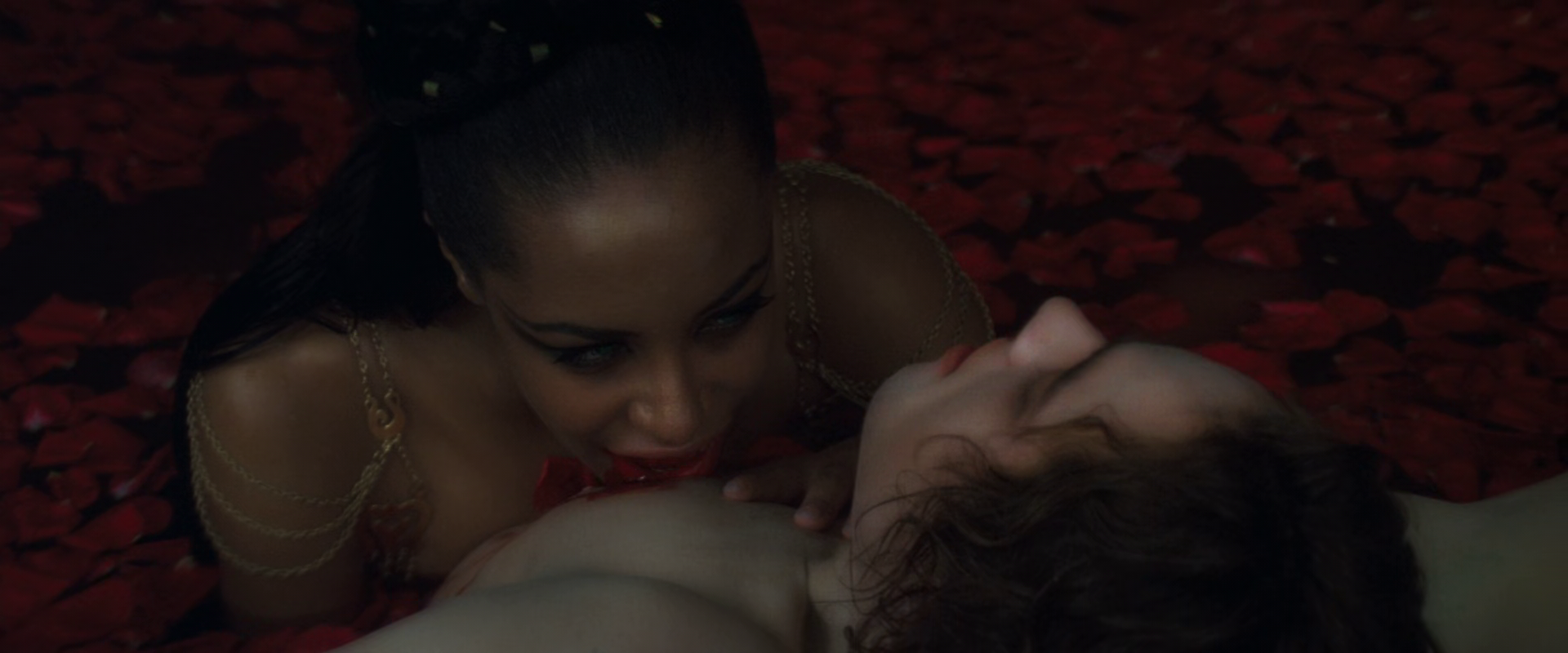
It’s a stretch to say she’s “really good” in this because nothing in this movie is “really good,” and there absolutely aren’t the necessary raw materials present in the script or direction for her to have turned in a performance that elevates the film. But she’s clearly a star, and she exudes that star power from the moment she steps on screen to the moment her character dies a ludicrously overwrought CGI death to close out the film. There’s a better version of this film that strays completely from Anne Rice’s source material and makes her the goddess-rock star character instead of Lestat, and instead of that goofy fight scene conveyed above, we get a version of the iconic Central Park stage performance scene from the first Parasite Eve game, except Akasha uses the dreadful power of the blood to liquify and consume the audience instead of the dreadful power of mitochondria, which is the powerhouse of the cell.
For some reason fire is actually Akasha’s main weapon of choice, and vampires she kills burst into flames. I don’t recall this being a main focus of the character’s from the source material, and my suspicion is that this is a conceit of the film because fire is relatively easy to achieve as a computer effect and extremely easy to achieve as a practical one, much more so than liquid blood. There’s an entire C-plot to this film running through flashbacks to both Lestat’s and Jesse’s past that explain the lore behind who Akasha is and who the good guy vampire cult that shows up to help Lestat, Marius, and Jesse defeat the Queen of the Damned are, but it’s sloppy, vestigial, and uninteresting — the wages of Warner Brothers deciding to just adapt the second and third Anne Rice books they had rights to into one film rather than lose the rights entirely, with predictably poor results. The movie finally gets rolling as Akasha spirits Lestat away to an island paradise to fuck him, feed on him, feed her blood back to him, and give him the power to walk in the daylight…which he realizes upon walking outside the next morning and seeing that Akasha has butchered every man, woman, and child on the island while he slept. Now we’re talking. Now we’re gonna see some stuff. Now the rivers of blood are — wait, there’s only 20 minutes left in this thing? What?
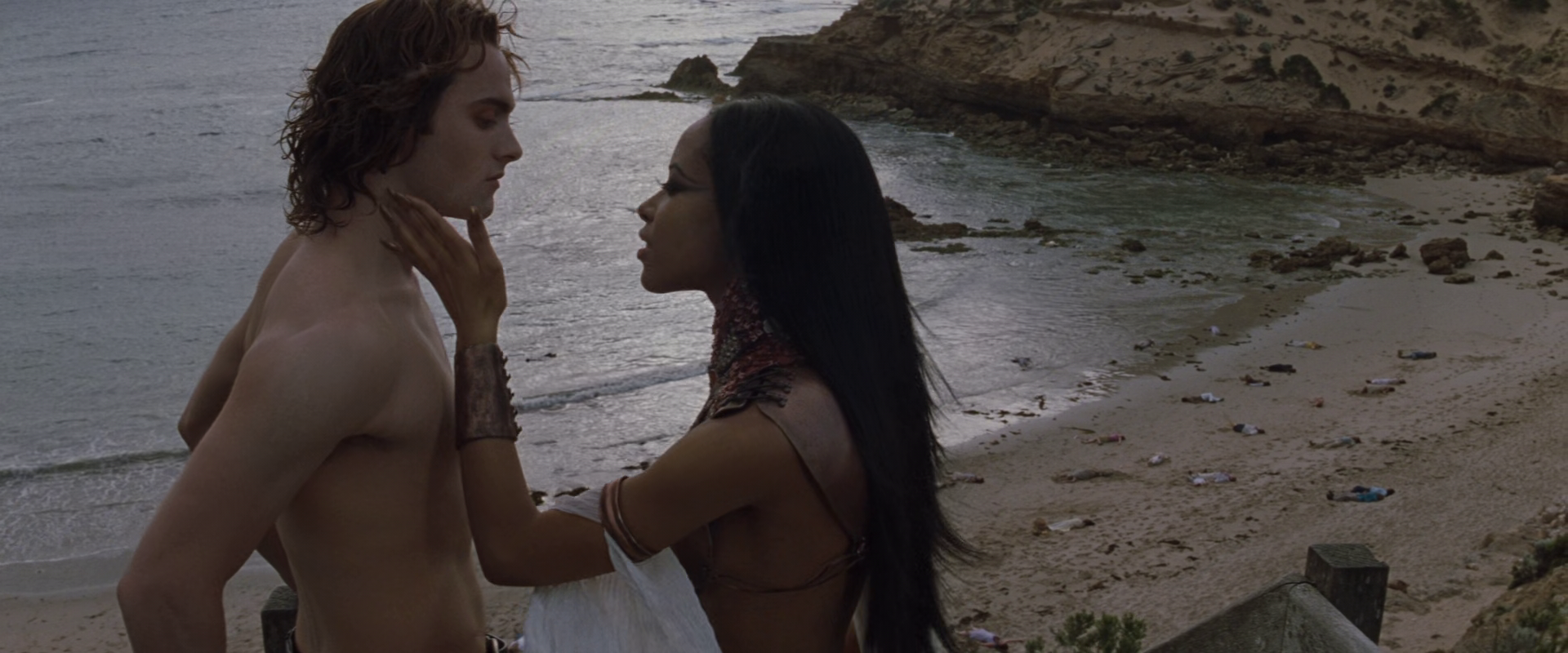
The movie rushes to its finale with everyone showing up on the good guy vampire family estate for a showdown. Lestat, who has been working for the enemy for all of six minutes of screen time tops, obviously immediately betrays the Queen of the Damned and he and the good guy vampires drink her dry (there’s a plot gimmick established early on that the vampire who drinks the last drop of Akasha’s blood will be turned into a statue, so Jesse’s vampire mom we haven’t seen since her character was introduced all the way back at the beginning of the movie takes that bullet). Jesse, who Lestat had to feed on to prove his loyalty to Akasha immediately before betraying her, gets her wish of being turned into a vampire, and the power couple stalks out into the London night to end the film.
So, not a good movie, and the parts of it that I liked were for reasons that I doubt the makers of the film intended, but what would they know? “Vampire rock star” is an inherently funny idea and Queen of the Damned played around in that idea space in ways that are at least fun to think about and talk about a little, even if they’re more comedy than broody serious business. Aaliyah proved she would have had a hell of a career even with slapdash material. Both things are far more worth taking a look at than anything BloodRayne did, I’ll tell you that much.
Haven’t decided on what’s up next from the 90s Vampire films; probably Interview with a Vampire since I’m already dealing with Lestat-related business. We’ll see if I change my mind over the weekend.
Have any questions or feedback? Drop us a note in the comments below or email us at contact@goonhammer.com. Want articles like this linked in your inbox every Monday morning? Sign up for our newsletter. And don’t forget that you can support us on Patreon for backer rewards like early video content, Administratum access, an ad-free experience on our website and more.
